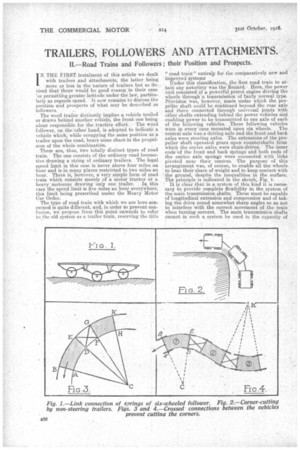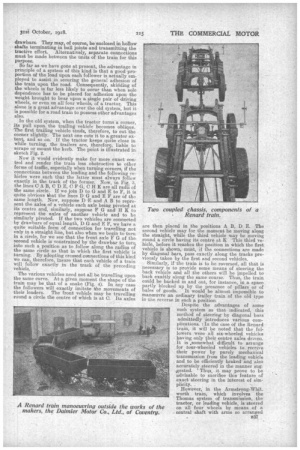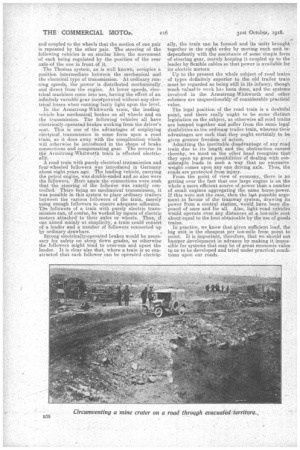TRAILERS, FOLLOWERS AND ATTACHMENTS.
Page 16

Page 17

Page 18

If you've noticed an error in this article please click here to report it so we can fix it.
IL—Road Trains and Followers ; their Position and Prospects.
IN THE FIRST instalment of this article we dealt with trailers and attachments, the latter being more or less in the 'nature of trailers but so devised that there would be good reason in their case or perinitti'ng greater latitude under the law, particularly as regards speed. It now remains to discuss the position and prospects of what may be described as to 11 owers.
The word trailer distinctly implies a vehicle trailed or drawn behind another vehicle, the front one being alone responsible for the tractive effort. The word follower, on the other hand, is adopted to indicate a vehicle which, while occupying the seine position as a trailer upon the road, bears some share in the propulsion of the whole combinaticin.
Them are, thus, two totally distinct types of road train. The one consists of the ordinary road locomotive drawing a string of ordinary trailers. The legal speed limit in this case is never above four miles an hour and is in many places restricted to two miles an hour. There is, however, a very simple form of road • train which consists merely of a motor tractor or a heavy motorcar drawing only one trailer. In this ease the speed limit is five miles an hour everywhere, this limit being prescribed under the Heavy Motor Car Order.
The type of road tram with which we are here concerned is quite different, and, in order to prevent confusion, we propose from this point onwards to refer to the old system as a trailer train, reserving the title
"road train" entirely for the comparatively new and improved systems Under this classification, the first road train to attain any notoriety was the Renard. Here, the power unit consisted of a powerful petrol engine driving the wheels through a transmission of fairly normal type. Provision was, however, made under which the propeller shaft could be continued beyond the rear axle and there connected through universal joints With other shafts extending behind the power vehicles and enabling power to be transmitted to one axle -of each of the following vehicles. These following vehicles were in every 'case mounted Upon six Wheels. The central axle was a driving axle and the front and back axles were steering axles. The extensions of the propeller shaft operated gears upon countershafts from which the Centre axles were chain-driven. The inner ends of the front and back springs and both ends of the centre axle springs were connected with links pivoted near their centres. The purpose of this arrangement was, of course, to enable all the wheels to bear their share of weight and to keep contact with the ground, despite the inequalities in the surface. The principle is indicated in the sketch; Fig. 1.
It is clear that in a system of this kind it is necessary to provide complete flexibility in the system of the main transmission shafts. These must be capable of longitudinal extension and compression and of taking the drive round somewhat sharp angles so as not interfere nterfere with the correct movement of the train when turning corners. The main transmission shafts cannot in such a system be used in the capacity of
drawbars. They may, of course, be enclosed in hollow shafts terminating in ball joints and transmitting the tractive effort. .Alternatively, separate connections must be made between the units of the train for this purpose.
So far as we have gone at present, the advantage in principle of a system of this kind is that a good proportion of the load upon each follower is actually employed to assist in securing the general adhesion of the train upon the road. Ultonsequently, skidding of the wheels is far less likely to occur than when sole dependence has to be placed for adhesion upon the
weight brought to bear upon a. single pair of driving wheels, or even on all four wheels, of a tractor. This alone is a great advantage over the old system, but it is possible for a road train to possess other advantages also.
In the old system, when the tractor turns a corner, its pull upon_ the trailing vehicle becomes oblique. 'The first trailing vehicle tends, therefore, to cut the corner slightly. The next one cuts it to a greater extent, and so on. If the tractor keeps quite close in while turning, the trailers are, therefore, liable to scrape or mount the kerb. The point is illustrated in sketch Fig. 2.
Now it would evidently make for more exact control and render the train less obstructive to other forms of traffic, especially when turtling corners, if the connections between the leading and the following vehicles were such that the latter must always follow exactly in the track of the former. Now, in Fig, 3, the lines C A B, C D E, C F G, C H K are all radii of the same circle. If we join D to G and E to F, it is quite obvious that the lines D G and E F are of the same length. Now, suppose D E and A B to represent the axles of a vehicle each axle being pivoted at its centre and, similarly, suppose F G and H K to represent the axles of another vehicle and to be similarly pivoted. If the two vehicles are connected by drawbars of equal length, D G and E F, we have a quite suitable form of connection for travelling not only in a straight line, but also when we begin to turn in a circle, for we see that the front axle F G of the.
second vehicle is constrained by the drawbar to tura into such a position as to follow along the radius of the same circle as that in which the first vehicle is turning. By adopting crossed connections of this kind we can, therefore, insure that each vehicle of a train will follow exactly in the track of the preceding vehicle.
The various vehicles need not all be travelling upon the same curve. At a given moment the shape of the train may be.that of a snake (Fig. 4). In any case the followers will exactly imitate the movements of their leaders. The front vehicle may be travelling round a circle the centre of which is at C. Its axles
are then placed in the positions A B, D E. The second vehicle may for the moment be moving along the straight, while the third vehicle may be moving round a circle having its centre at K This third vehicle, before it reaches the position in which the first vehicle is shown, must, if the connections are made by diagonal bars, pass exactly along the tracks previously taken by the first and second vehicles. Similarly, if the train is to be reversed, all that is
i necessary s to provide some means of steering the back vehicle and all the others will be impelled to back exaCtly along the same course. This, the train could be backed in and out, for instance in a space partly blocked up by the presence of Pillars or of bales of goods. It would be almost impossible to manceuvre an ordinary trailer train of the old type in the reverse in such a position
Despite the advantages of some such system as that indicated, this method of steering by diagonal bars admittedly introduces various complications. t In the case of the Renard train, it will be noted that the followers were all six-wheeled vehicles having only their centre axles driven. It is ,somewhat difficult to arrange for tour-wheeled vehicles to receive their power by purely mechanical transmission from the leading vehicle and to be efficiently braked and also accurately steered in the manner suggested. ' This, it may prove to be advisable to sacrifice this feature of exact steering in the interest of simplicity. However,. in the Armstrong-Whit_ worth train, which involves the Thomas system of transmission, the tractor, or leading vehicle, is steered on all four wheels by means of a central shaft with arms so arranged and coupled to the wheels that the motion of one pair is repeated by the other pair. 'The steering of tha following vehicles is on similar lines, the movement of each being regulated by the position of the rear axle-of the one in front of it. The Thomas system, as is well known, occupies a poSition intermediate between the mechanical and the electrical type of transmission. At ordinary running speeds, the power is distributed mechanically. and direct from the engine. At lower speeds, electrical machines come into use, having the effect of an infinitely variable gear inccerporated without any.electrical losses when running fairly light upon the level.
In :the Armstrong-Whitworth train, the leading vehicle has mechanical brakes on all wheels and on the transmission. The following Vehicles all have 'electrically-operated brakes working from the driver's seat.. This is one of the advantages of employing electrical, transmission in some form upon a road tiain, as it does away with the complication which Will otherwise be introduced in the shape of brake. connections and comPensating gear. The reverse in tlfei Armstreng-Whitworth train is effected electric ally, • A road train with purely electrical transmission and four-wheeled followers was introduced in Germany about eight years ago. The leading vehicle, carrying the petrol engine, was double-ended and so also were the followers. Here again the connections were sualt that the steering of the follower was exactly controlled. There being no mechanical transmission, it was possible in -this_ system to place ordinary trailers between the various followers of the train, Merely. using enough followers to ensure adequate adhesion, The .folloWers of a train, with purely electric transmission can, of couise, be worked by moans of electric motors attached to their axles or wheels. Thus,if one aimed mainly -at .simplicity, a, train could consiSt of -a leader and a number of followers connected up by ordinary drawbars. Strong electrically-operated brakes would be necessarY fee safety on steep down grades, as otherwise the followers might tend to over-run and upset the leader. It is clear also that, where a train is so eonstrticted that each follower can be operated electric ally, the train can be formed and its units brought together in the right order by moving each unit independently with the assistance of some simple form of steering gear, merely keeping it coupled up to the leader by flexible cables so that power is available for its eleetric motors.
Up to the present the whole subject of road trains of types definitely superior to the old trailer train must be regarded as being still in its infancy, though much valuahle werk has been done, and the systems involved in the. Armstrong-Whitworth and. other • schetnes are unquestionably of considerable practiCal value. • The legal position of the road train is a deubtful point, and there really ought to be some distinct legislation on the subject, as otherwise all road trains are lumped together and _stiffer from the santelegal disabilities as the ordinars7 trailer train, whereas their advantages are such that they ought certainly to be given greater freedom of action. , Admitting the inevitable disadvantage of any road train due to its length and the obstruction caused thereby, we must on the other hand recognize that -they open -up great possibilities 'Of dealing with consideraPle loads in Such a way that no excessive weight comes upon any one driving axle. Thus, the roads are protected from injury. . From the point of view of economy, there is no getting over the fact that one large engine is on the whole a more efficient source of power than a number of small engines aggregating the same horse-power. If this were not the ease, then the la,st possible argument in favour of the tramway -system, drawing its power from a central station, would have been disposed of once and for all. Also, light road vehicles would operate over any distances at a ton-mile cost about equal to the best obtainable by the use of goods trains.. In practice, we know that given sufficient. load, the bier unit is the cheapest per ton-Mile from point to point. It is important, therefore, that we should not hamper development in advance by making it impossible for systems that may be of great economic yalue te -us to he developed and tried under practical conditions upon our roads.






















